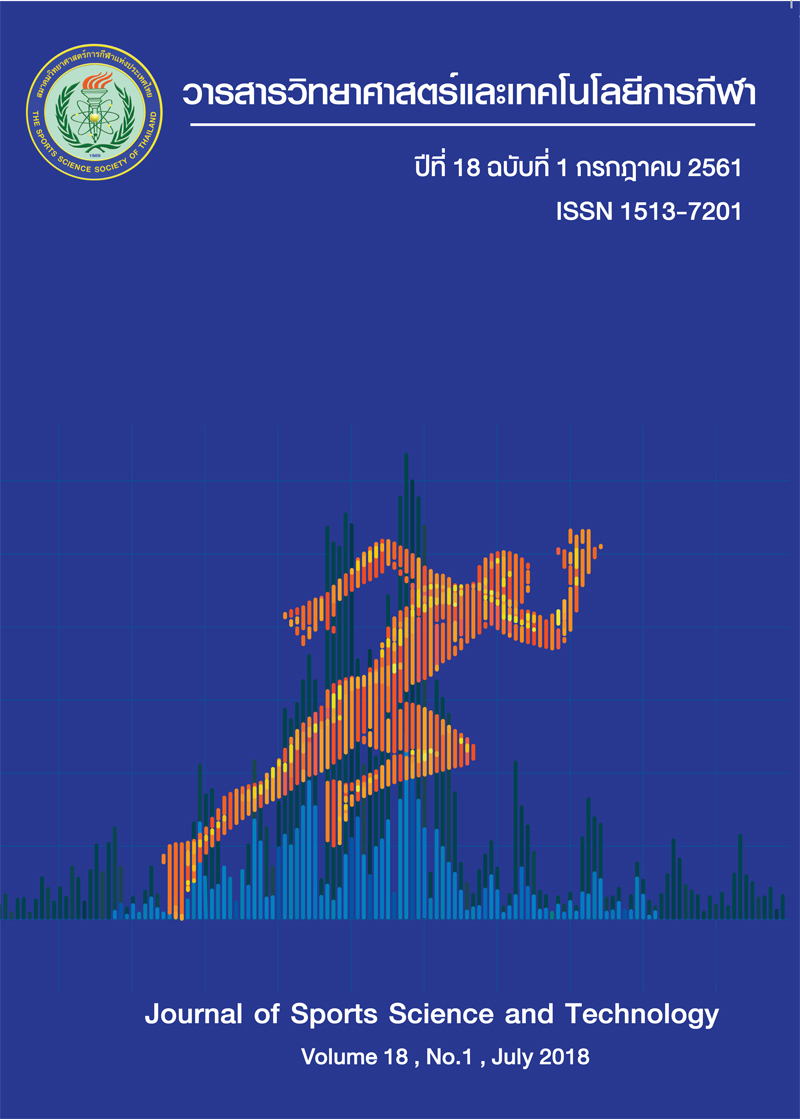EFFECTS OF INJURY PREVENTION TRAINING PROGRAM ON H/Q RATIO, 3-WAY STAR EXCURSION BALANCE TEST IN HIGH SCHOOL MALE BASKETBALL PLAYERS
Keywords:
Injury Prevention Program / Anterior cruciate ligament / Lower extremity injuryAbstract
The purpose of study was to determine whether the Sports Injury Prevention Training Program (SIPTP), trained 3 times per week for 6 weeks was effective in terms of improving flexibility, isokinetic H/Q ratio, balance and muscle power which were the implication for the risk of lower extremity injuries. A total of 26 high school male basketball players, age range between 13-18 years, were randomly divided into 2 equal groups: (the intervention and the control groups). The intervention group was instructed to follow the 6 parts of the SIPTP (20 minutes), while the control group performed their regular training program. Both groups were tested with sit-and- reach test, isokinetic H/Q ratio, star excursion balance test (SEBT) and vertical jump test before and after the 6- week period. This study was a randomized controlled trial study in which two-way repeated measures ANOVA was used for analysis between and within groups, respectively. Statistical significance was considered at p< 0.05. The result showed that SEBT and flexibility value were significantly higher in intervention group than control group. Moreover, the values of SEBT, vertical jump, and H/Q ratio in the intervention group were significantly increased after 6 weeks of SIPTP. This study found that increased isokinetic H/Q ratio, SEBT and vertical jump test after 6 weeks of the SIPTP in high school male basketball players indicated that the program may help to prevent the injuries of lower extremity in young basketball players.
Journal of Sports Science and Technology 2018; 18(1): 49-58
References
2. Arendt E, Dick R. Knee injury patterns among men and women in collegiate basketball and soccer. NCAA data and review of literature. Am J Sports Med. 1995;23(6):694-701.
3. Plisky PJ, Rauh MJ, Kaminski TW, Underwood FB. Star Excursion Balance Test as a predictor of lower extremity injury in high school basketball players. The Journal of orthopaedic and sports physical therapy. 2006;36(12):911-9.
4. Chang E, Norcross MF, Johnson ST, Kitagawa T, Hoffman M. Relationships between explosive and maximal triple extensor muscle performance and vertical jump height. J Strength Cond Res. 2015;29(2):545-51.
5. Paz GA, Maia MdF, Farias D, Santana H, Miranda H, Lima V, et al. Kinematic analysis of knee valgus during drop vertical jump and forward step-up in young basketball players. International Journal of Sports Physical Therapy. 2016;11(2):212-9.
6. Borowski LA, Yard EE, Fields SK, Comstock RD. The epidemiology of US high school basketball injuries, 2005-2007. Am J Sports Med. 2008;36(12):2328-35.
7. Mandelbaum BR, Silvers HJ, Watanabe DS, Knarr JF, Thomas SD, Griffin LY, et al. Effectiveness of a Neuromuscular and Proprioceptive Training Program in Preventing Anterior Cruciate Ligament Injuries in Female Athletes: 2-Year Follow-up. Am J Sports Med. 2005;33.
8. Longo UG, Loppini M, Berton A, Marinozzi A, Maffulli N, Denaro V. The FIFA 11+ Program Is Effective in Preventing Injuries in Elite Male Basketball Players: A Cluster Randomized Controlled Trial. The American Journal of Sports Medicine. 2012;40(5):996-1005.
9. Lim BO, Lee YS, Kim JG, An KO, Yoo J, Kwon YH. Effects of sports injury prevention training on the biomechanical risk factors of anterior cruciate ligament injury in high school female basketball players. Am J Sports Med. 2009;7.
10. Hewett TE, Lindenfeld TN, Riccobene JV, Noyes FR. The Effect of Neuromuscular Training on the Incidence of Knee Injury in Female Athletes: A Prospective Study. The American Journal of Sports Medicine. 1999;27(6):699-706.
11. Baltaci G, Un N, Tunay V, Besler A, Gerçeker S. Comparison of three different sit and reach tests for measurement of hamstring flexibility in female university students. British Journal of Sports Medicine. 2003;37(1):59-61.
12. Plisky PJ, Rauh MJ, Kaminski TW, Underwood FB. Star Excursion Balance Test as a predictor of lower extremity injury in high school basketball players. The Journal of orthopaedic and sports physical therapy. 2006;36(12):911-9.
13. Burr JF, Jamnik VK, Dogra S, Gledhill N. Evaluation of jump protocols to assess leg power and predict hockey playing potential. J Strength Cond Res. 2007;21(4):1139-45.
14. Cheung R, Smith A, Wong D. H:Q Ratios and Bilateral Leg Strength in College Field and Court Sports Players. Journal of Human Kinetics2012. p. 63.
15. Steffen K, Nilstad A, Krosshaug T, Pasanen K. No association between static and dynamic postural control and ACL injury risk among female elite handball and football players: a prospective study of 838 players. 2017;51(4):253-9.
16. McGuine TA, Greene JJ, Best T, Leverson G. Balance as a predictor of ankle injuries in high school basketball players. Clin J Sport Med. 2000;10(4):239-44.
17. Chappell JD, Limpisvasti O. Effect of a neuromuscular training program on the kinetics and kinematics of jumping tasks. Am J Sports Med. 2008;36(6):1081-6.
18. Markovic G, Mikulic P. Neuro-Musculoskeletal and Performance Adaptations to Lower-Extremity Plyometric Training2010. 859-95 p.
19. Soderman K, Alfredson H, Pietila T, Werner S. Risk factors for leg injuries in female soccer players: a prospective investigation during one out-door season. Knee surgery, sports traumatology, arthroscopy : official journal of the ESSKA. 2001;9(5):313-21.
20. Cheung R, Smith A, Wong D. H:Q Ratios and Bilateral Leg Strength in College Field and Court Sports Players. Journal of Human Kinetics2012. p. 63.
21. Lee JWY, Mok KM, Chan HCK, Yung PSH, Chan KM. Eccentric hamstring strength deficit and poor hamstring-to-quadriceps ratio are risk factors for hamstring strain injury in football: A prospective study of 146 professional players. Journal of science and medicine in sport. 2017.






